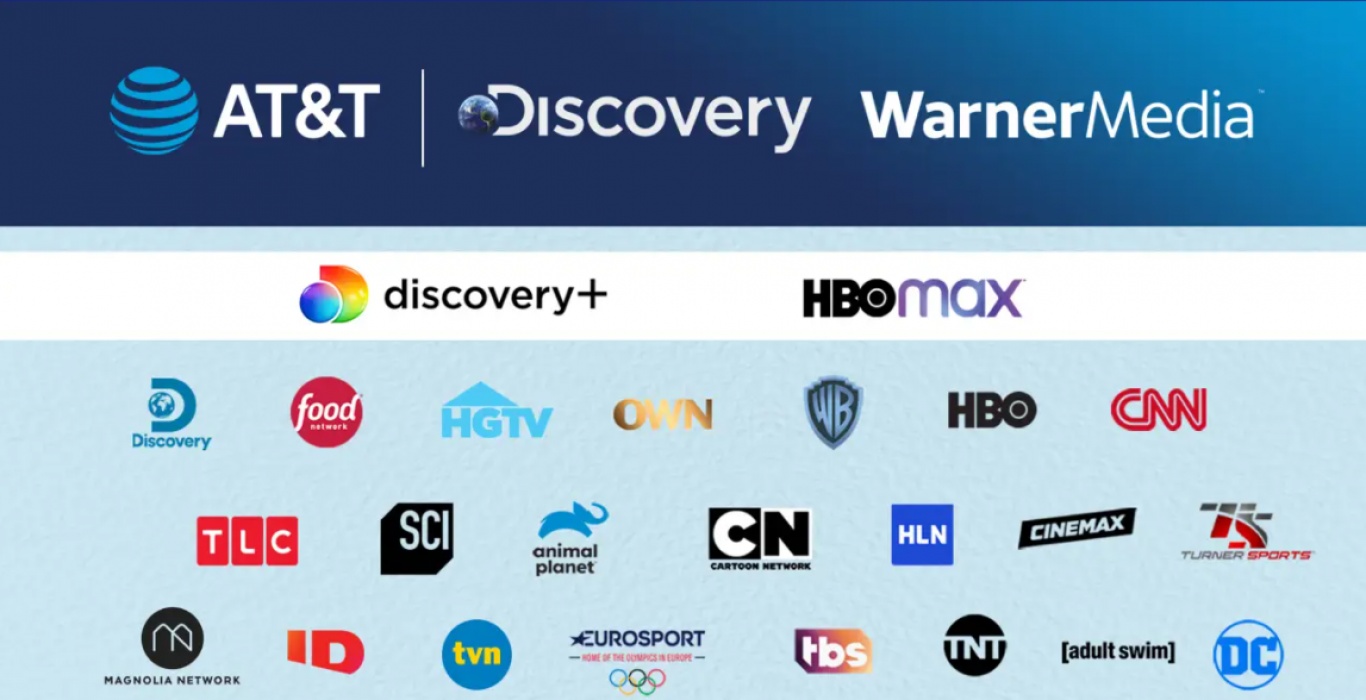
AT&T / WarnerMedia / Discovery: a massive, major course-correcting merger
Huge industry news has broken in the past few days as AT&T announced a $43 billion deal to spin off its media content division, WarnerMedia, and merge it with Discovery, to form “a new global media superpower to take on streaming services Netflix and Disney+”.
It’s a move with massive implications for the streaming landscape, which is why Frame 25 is diving deep in the details.
The deal
This merger is potentially massive, and makes a lot of sense.
Under the deal, AT&T, which has a market value of $230 billion and will become a purely telecommunications business once more, will receive $43 billion in cash and debt securities and take a 71% stake in the new company. Discovery, which has a market value of about $20 billion, will hold the remaining 29%.
If approved by regulators, the deal effectively reverses AT&T’s years-long plan to combine content and distribution in a vertically integrated company. The companies said the deal is expected to close in the middle of 2022. – CNBC
Vertical vs horizontal
Vertical mergers
By contrast, vertical mergers are those involving two or more firms offering different functions for a common good or service. Such mergers are intended to create greater efficiency or scale. AT&T’s acquisition of Time Warner in 2018 was vertical since it combined firms operating at different points of the production and distribution chain.
It was an integration regarded by many as questionable: the acquisition by AT&T, a telecommunications company, of Time Warner, a media and entertainment company, for $85 billion did not stack up. As Edmund Lee, who covers the media industry for The New York Times, suggested in 2016:
“A company that owns pipes, whether over the air or through the ground, doesn’t actually benefit from owning the content flowing through those pipes.”
Horizontal mergers
Two or more firms in the same industry – possibly in direct competition – and with similar products combining into one company is known as a horizontal merger.
Examples include the integration of Facebook, WhatsApp and Instagram. All were independent social media platforms started by different companies before Facebook acquired first Instagram and then WhatsApp to form part of one large business.
In opposing horizontal mergers, regulators typically argue that the combined firm would reduce competition for that particular product, inflate prices and diminish consumer choice.
‘A’ list brands and titles
WarnerMedia owns CNN and the studio behind the Batman and Harry Potter franchises.
Discovery owns Eurosport and a number of networks including its flagship, Discovery Channel.
Other titles and brands coming under the new entity’s umbrella include Friends, The Big Bang Theory, and the HBO network which produced Game of Thrones and Succession.
Bullish Zaslav
The AT&T/Discovery tie-up seeks to create a new player with the content and scale to compete with Netflix and Disney+, and David Zaslav, Discovery’s CEO, has been named chief executive of the new business and is targeting 400 million direct-to-consumer homes.
He’s bullish about his company’s move and believes the deal will create “a globally scaled growth company committed to a strong balance sheet that is better positioned to compete with the world’s largest streamers”.
“This company’s going to be a free cash flow machine,” he says.
“We’ve acquired Scripps, we acquired Eurosport, we’re a big player in Europe and free-to-air…and we think there’s some real revenue synergy opportunity here.
“The metrics of this business are compelling and if you look at the traditional business, it solidifies us. We’re the leader in nonfiction, and on top of that we’re now the leader in news, so we have news, sports and nonfiction.”
Revenues at the business are predicted to be about $52 billion, and profits about $14billion. AT&T will appoint seven of its 13 board members, including the chairman.
Why is this move significant?
While the futures of the Discovery and WarnerMedia cable networks remain unclear, the shift from cable to streaming is abundantly evident.
Zaslav says we’re close to the point where companies believe increased streaming revenue outweighs potential losses incurred by serving dwindling numbers of cable customers.
He told a conference that the Discovery networks earn around $7 per subscriber on cable (including ad revenue), while the average subscriber to the ad-supported version of Discovery+ brings in between $10 and $11.
“If we lost a million [cable] subs, all we have to do is pick up 650,000 [Discovery Plus] subs in order to be making more money,” he said. “That’s one of the reasons why we’re investing in Discovery Plus.”
Not the first U-turn
While it’s clear how the deal makes economic sense, the road that’s brought AT&T to this point has been rocky.
AT&T acquired media assets in its $85 billion takeover of Time Warner in 2018.
That followed a failed $39 billion bid to buy T-Mobile (which ended up costing AT&T $3 billion) and the $67 billion acquisition ($48.5 billion plus debt) in 2015 of the satellite TV service DirectTV.
AT&T has recently been engaged on a strategy going the other way.
In February, the company agreed to sell a majority stake in DirecTV, which has been losing tens of millions of customers as viewers move to streaming, in a deal that valued the business at a quarter of the price it was bought for.
John Sankey, who was promoted from chief operating officer to CEO last July, has also offloaded AT&T’s digital advertising division and Crunchyroll, an anime cartoon streaming app.
The merged business, which is subject to regulatory approval and has yet to be named, will begin its life with an enterprise value of $150 billion but $58 billion in debt.

Significant job cuts are expected as a result of combining the two businesses, which will bring savings of “at least $3 billion” annually.
Something different?
In such a competitive market, dominated by Netflix, Amazon and Disney+, Zaslav is right in his assessment that his new company will be able to differentiate from its rivals by offering news and sports as well as world-class entertainment brands such as Game of Thrones and Harry Potter.
AT&T and Discovery spend a combined $20 billion per year on content, comparing favourably with Netflix, which currently spends about $17 billion.
Questions, decisions and other considerations
This latest deal represents a major course correction by AT&T, and confirms shareholder fears that that 2018 merger with Time Warner was not fully thought-out.
And the AT&T/Discovery merger raises several questions, too.
One is whether the new business rolls each brand into multiple channels (bundle) to maintain them, or under one banner as a single entity with channels attached underneath it? For example, do HBO Max and Discovery+ continue as separate apps, get combined into something bigger, or both?
Beyond that, what does this mean for all the Discovery and WarnerMedia cable networks? And for other industry players such as Comcast Peacock and Sky UK?
One consideration where Sky is concerned is WarnerMedia’s deal with the broadcaster which runs until 2025.
WarnerMedia is expanding its HBO Max streaming service into 60 countries outside the US later this year, including 21 countries in Europe.
But the service won’t launch in the UK, Germany or Italy because Sky has an exclusive content distribution agreement with WarnerMedia for HBO content.
In this context, Sky’s rush to create a large-scale studio operation and create their own content makes perfect sense.
Where this leads a huge and growing market
Globally, the biggest SVOD platforms are enjoying extraordinary growth. Netflix has more than 200 million subscribers, Amazon more than 175 million, and Disney+ already has more than 100 million after launching in November 2019.
Further down the pecking order, multiple services including Apple TV+, Peacock and many others try to capture market share as people across the world spend more time at home than ever because of Covid-related lockdowns and travel restrictions.
What’s emerging more clearly than ever is the idea that media companies in the streaming age need to become big or get out of the game.
Let’s not forget the role Netflix has played as we’ve shifted from bricks-and mortar video rental outlets to sending DVDs through the post and on again to streaming. Netflix has pivoted and led throughout. Amazon has done likewise in every industry it has touched, and now Disney is showing its mettle, too.
Where this latest merger takes us and how the industry adapts to an ever evolving landscape will be very interesting to watch as it unfolds.

Umbrella Company Reforms - An Overview

Product + audience + platform: why the Premier League is going its own way
